As an Amazon Associate, I earn from qualifying purchases. Additionally, I earn a commission through each purchase made on Amazon, Clickbank, zZounds, Plugin Boutique, Plugin Fox, Thomann, Jam Play, and Punkademic from one of my links.
In this article today, I’m going to show you the two best interfaces for Garageband users, as well as offer an explanation of all their usual functions, including what those confusing specifications actually mean.
The best audio interface for beginners to Garageband is the Focusrite Scarlett 2i2, which is definitely the most suggested as well.
The second best audio interface for Garageband, in my opinion, is the iRig Pro I/O, which is not only for guitars but also for microphones.
The Scarlett 2i2 has more than one port/channel, which means you can use it for a microphone as well as another instrument at the same time. The iRig Pro I/O is more for taking on the road.
What Is An Audio Interface And What Does It Do?
In layman’s terms, an audio interface is the piece of equipment that – through the conversion of analog to digital information – allows us to hook up all of our musical gear to our computer.
An audio interface like the Scarlett 2i2 (from Amazon) turns regular sound into a form of information that the computer can process, and it can also turn digital information into a sound capable of being heard by the human ear.
It acts literally as an interface between the sound and the computer. Or, in other words, it’s as if the audio interface is translating the soundwaves into a language the computer can understand.
The vast majority of computers out there come with an in-built digital audio interface that translates digital information into sound, moreover, some of the better models like this MacBook Pro from Amazon have better in-built audio interfaces than others.
This is called a soundcard, and an audio interface is like an external soundcard. This is what allows the computer to play music through Music/iTunes and other music playing platforms. Universal Audio’s Apollo Twin (again from Amazon) is a great example of a professional quality soundcard.
Before diving into my favorite interfaces for Garageband, let’s talk about the differences between Analog and Digital soundwaves, which will help illuminate why they’re important as well as guide you in your purchase of the right product.
Understanding Audio Interfaces – Analog Versus Digital
The primary difference between Analog and Digital is that Analog recording is a continuous wave format recorded by some kind of electrical or mechanical equipment.
Digital recordings are recordings that are broke up into data packages processable by a computer.
Why Do I Need An Audio Interface?
Music producers and musicians, and more generally, people who work with sound a lot, will eventually come to a point where they need a higher-quality device to increase the quality of the computer’s sound.
Moreover, as I explained in my guide on recording acoustic guitars, to record external instruments and other sounds, an audio interface is essential.
A quality audio interface is crucial for music producers, musicians, and audio engineers because the average soundcard in a computer simply doesn’t cut it.
An audio interface is important because it not only performs the crucial function of translating sounds so the computer can actually play it back in a manner audible to the human ear but also to increase the possibilities when it comes to our set-up.
For instance, with more outputs and inputs, we can greatly increase just how much can be done in our home recording studio.
As I mentioned above, we’re going to explain the specifications and functions of the average audio interface, as well as some of the confusing terminology.
1) Focusrite Scarlett 2i2
Click the link here to check the price on Amazon.

One of my greatest pet peeves when it comes to buying products is how it’s actually built. Many products nowadays seem like they’re not built to last because they’re often made out of cheap plastic.
However, with Focusrite products, they’re always well-built and they seem as though attention and consideration have gone into their product’s construction.
I have a Focusrite Saffire 6USB which is the exact same way. The 6USB is made entirely of hard metal and it has lasted me for a little over a decade. It still works, by the way.
What Comes With The Focusrite Scarlett 2i2
- In terms of what comes in the box with it, you get the USB-C to USB-A Cable.
- You also get Pro Tools one, which includes hundreds of different instruments as well as loops.
- Ableton Live. Ableton Live is a digital audio workstation, that like Pro Tools and other DAWs, comes with effects, instruments, sequencers, arpeggiators, etc.
The difference between Ableton Live and other DAWs is that it’s meant for live performances and can be synchronized with lighting systems and so on. I’ve never used it before but I’ve heard it’s great for performers.
- Soft tube, which are plug-ins created by Focusrite, including reverb, delay, and distortion.
- Focusrite’s Red Plug-in Suite, which includes an EQ as well as a compressor.
And that’s about it.
All of the other stuff that you can get is downloadable from Focusrite on their website.
As I mentioned above, Focusrite’s products are typically very-well built. In this case, it’s made out of a red aluminum housing, and then the front and back of it are made out of plastic.
The knobs and the dials have a very sturdy feel to them, so you don’t have to worry about them falling off or breaking within just a few weeks, months, or even years, as long as you’re careful with it.
Moreover, the buttons have a tactile feel to them. In other words, when you’ve pushed the button, it actually clicks and you know that you’ve pressed it and there’s no confusion as to whether it’s turned on or not.
On the front of the machine, it has two separate channels with the XLR Jack as well as the 1/4 inch input.

An XLR input and output are connectors that are meant for professional audio recording equipment. They typically have between three and seven prongs on them.
They’re known for being “balanced,” and not as susceptible to signal interference. Many cameras and microphones employ an XLR cable like this one from Amazon.
In comparison to a regular jack connection, which is usually unbalanced, the cables are a single prong, for instance, a headphone ‘jack.’
The “Gain” dial flashes red when you’ve turned the gain up too much. If you’re using too much, the interface lets you know. When it’s clipping, it turns red, and when it’s green, it stays a nice soft Green color.
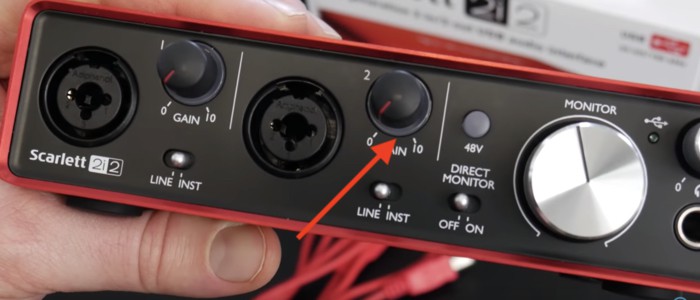
They also have the “Instrument” button which allows you to switch from the line-level and the instrument level whenever you’re using a 1/4 input jack.
Before continuing, let’s unpack the difference between Instrument and Line Level.

Instrument Level refers to any signal that is created by an instrument, but it’s most commonly used to describe the signals coming from a bass guitar or a guitar.
The power of an Instrument’s signal is typically lower than the signal generated by a microphone.
To increase the strength of the signal up to line level, a preamp is typically needed.
Line Level, on the other hand, describes what are the highest level signals. It is the signal that flows through the recording system after it’s passed through the preamplifier stage, but before the amplifier which gives power to the speakers.
I also emailed Focusrite about it and here was their response:
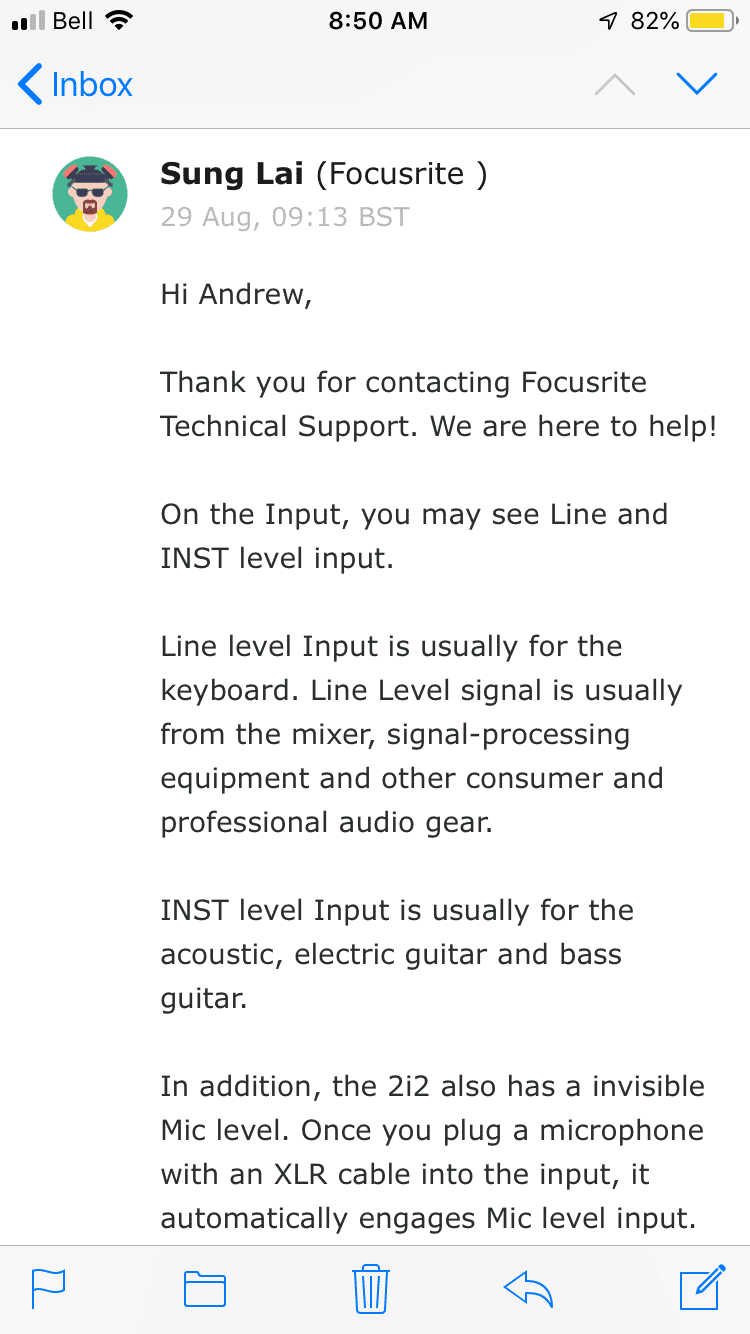
The Scarlett 2i2 also has the “Air” button, which is a new feature that wasn’t on my old 6USB. The “Air” button is a higher-end circuit that’s commonly a part of their higher-end products.

According to Focusrite’s page, the “Air” button emulate certain characteristics of an analog recording.
Their website explains the “Air” function in a very confusing way, but essentially, its purpose is to mimic a classic analog-style recording which has more “air and clarity.”
I also reached out to Focusrite and asked them what the button does and how it works, and here’s what they said.


It also comes with the 48V Phantom Power button to turn it on and off, in addition to the Direct Monitoring button.

The idea behind Phantom Power is to send power to some microphones that need it. It’s used to either drive active circuitry or to activate the plates within a condenser microphone (my personal favorite right now is the AT2021 from Amazon).
In other words, some microphones need phantom power – an alternative source of power – and therefore, this audio interface provides that.

As it was just stated, a condenser microphone needs Phantom Power whereas a Dynamic Microphone does not. Ribbon mics apparently can be damaged by the addition of phantom power.
The purpose of the Direct Monitoring allows you to, not only change between on and off if you want to listen while you’re singing (learn to sing with Singorama), but it also switches between Mono and Stereo.
The Monitoring button is a nice big dial and it takes up the most space on the interface.
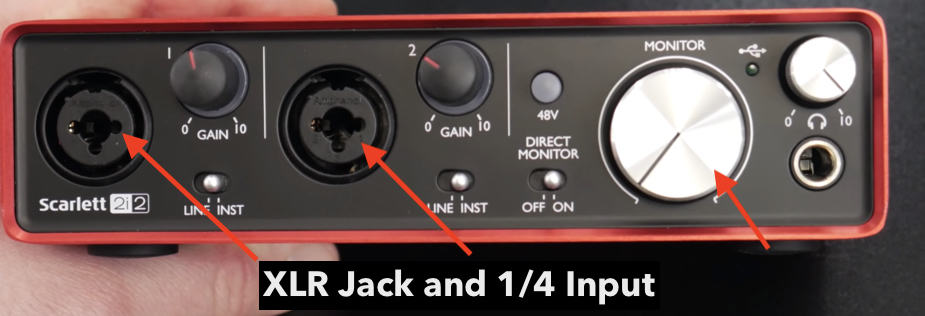
It also has the Headphone Volume control for when you’re listening with headphones, along with the 1/4 inch headphones input.

On the back of it, the Focusrite 2i2 comes with a USB-C port that way you can hook it up to other devices, in addition to the balanced left and right monitor outputs.

An unbalanced cable usually has just two connectors and two conductors each, whereas a balanced cable has three prongs. An unbalanced cable would be a guitar cable, and a balanced cable would be that of a microphone.
As it was just stated, a cable that carries an unbalanced signal typically has two wires, a ground, and a signal.
Unbalanced cables can often pick up noise as the signal travels through the cable, so for that reason, they’re typically used for short distances, like the guitar cable mentioned above. The idea behind the cable being short is that it picks up less noise.
The difference between a balanced and unbalanced cable is that the balanced one has a ground wire, and it also comes with two identical versions of the same audio signal.
One is usually described as “hot” while the other is referred to as “cold” – positive and negative respectively.
On account of the fact that one is positively charged and the other is negatively charged, they end up canceling each other out. This is also called “reverse polarity.”
The hot and cold signals travel to the end of the cable and because they’re identical, they end up canceling each other out, except the one with the noise attached to it is the one that’s canceled.
This is where the useful feature comes in: if the cable picks up undesirable sounds during its travel, when the polarity is reversed at the end, the noise that comes along with it is canceled out on account of the polarity of the cold signal matching the hot.
This is called “common-mode rejection.”
In other words, both signal wires, the hot and cold, carry the same “noise,” so to speak, and because they’re similar to each other, they end up canceling each other out. The effect of this is a noise-free cable.
Additionally, balanced signals have two synchronized signals, therefore, they tend to be much louder than unbalanced signals.
On the other hand, a cable with just a signal and a ground wire is an unbalanced cable.
The signal wire acts as a transportation device for the signal. The ground wire is for the sake of reference for the signal wire, but it also has the unintended consequence of accumulating undesirable sounds.
Due to the lack of the two wires that are hot and cold, there is no canceling of the undesirable sounds in an unbalanced cable, unlike the balanced cable.
I hope this illustrated what is meant by balanced and unbalanced, but let’s move on.
The balanced outputs on the back of the Focusrite Scarlett 2i2 are meant for speakers, for instance, the left speaker and the right speaker.
The Focusrite Scarlett 2i2 also has nice rubber stoppers on the bottom of it so that it doesn’t hurt your table and doesn’t slide around.
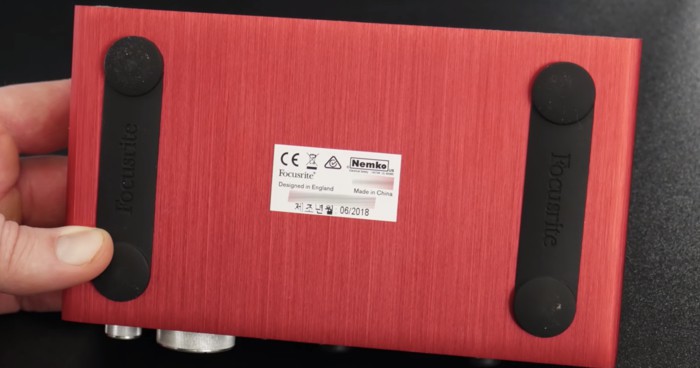
Let’s move on to the specifications of the unit.
It has a bit-depth of 24bit; a sampling rate of 192kHz, as well as a Gain range of 56db and a dynamic range of 111 dB.
If you were anything like me, these terms and specifications don’t mean a lot. So, let’s unpack what each one means.
What Is Bit-Depth?
The Bit-Depth is the number of “bits,” or pieces of information that are stored in each sample.
A Bit-Depth of 1, simply, means 6 dB. So a 16-bit audio clip, which is the standard for CDs, will have a dynamic range of 96dB. The digital noise floor tends to be quite high, so therefore the dynamic range is small.
The digital noise floor refers to the noise created by the actual system itself. Any kind of recording will pick up on undesirable sounds, for instance, an acoustic may have background noise and electronics will have thermal noise.
Moreover, there can be interfering signals from the environment as well. A digital measurement system will have within the system itself, noises that are undesirable.
Typically speaking, the more electronics there are in the system, the more noises there will be.
So, relating this back to the bit-depth, because the dynamic range is smaller, that means that recorded sounds at a lower volume may have more noise within them.
For that reason, the 24-bit audio range allows for a dynamic range of 144 dB, therefore, professionals are able to get a better-sounding recording.

In the graph I created which you can see above, there is the blue line and the red lines, and the blue line represents analog and the red lines represent digital.
You’ll notice that the analog one is one consistent line, whereas the digital line is chopped up into little squares.
Essentially, the grid-lines are meant to communicate what is known as “bit-depth.” The number of bits is basically how much information is recorded per sample.
The distance between each gridline represents one bit per line.
A sample is a term that describes the reduction of a continuous-time signal to a discrete-time signal.
In other words, it’s the transformation of a flowing and continuous signal into a signal that’s divided into individual “bits” or “parts”. For instance, converting an analog sound into a digital sound.
In other words, the more “bits” there are, the higher the quality of the information.
The fewer the bits, the fewer the number of information recorded in the sample.
This is why people argue that Analog is superior to Digital, because an Analog recording is capturing more information, thus, the sound is considered higher quality.
The specification, 16-bit, or 24-bit, represents how much information is recorded within each sample.
Using the example above, you can see how if there are more grid-lines, that means that the digital recording is capturing more of the sound, and it’s doing a better job of capturing all of the information because there are more points at which the digital recording is picking up the information.
Explained another way, if there are more grid-lines, and more “bits,” that means there will be more Red Squares, so to speak, therefore there is more information recorded in each sample.
If there are fewer grid-lines or “bits,” that means the soundwave will be chopped into fewer squares, and the recording will be choppier and not as good in quality.
The analog recording, represented by the blue line, is a continuous line in contrast to the digital which is chopped up into little squares.
I hope you’re able to see what’s being illustrated here.
For the sake of clarification, what I’m trying to say is that digital recordings are broken up into tiny little data packages, and the more data packages there are, the more information there is, therefore the quality of the recording is higher.
Analog, on the other hand, is not broken up into tiny little data packages. It’s just one long continuous recording.
Using an example, the common CD has a typical resolution of about 16-bits. Moreover, it’s also the standard by which most CDs and converters operate. While many can be much stronger than 16-bit, the consequence of this is that the computer’s processor will work much harder.
I hope this explanation has illuminated what is meant by “bit-depth.”
Let’s move on to the next specification that I laid out for the Focusrite Scarlett 2i2, the “sampling rate.”
What Is The Sampling Rate?
Both the sampling rate (not to be confused with the act of sampling music which I also have a guide on) as well as the bit-depth play a fundamental role in the quality of a digital recording.
From the explanation you just read above, you’ll see that its function is a bit easier to communicate. The sampling rate, however, is more sophisticated.
The sampling rate is the number of samples per unit of time, typically measured in seconds.
It refers to the rate at which samples are taken of an analog sound and converted into a digital sound. It’s kind of like a digital photo of the audio. The standard of measurement for communicating this signal is typically Hertz.
If you’re new to audio engineering, know that these frequency ranges used to be known as the level at which human beings can hear.
If you’re a dog person, you’ll know that they can pick up much higher frequencies, which is why dog whistles are a thing.
If you’ve ever had an amp with bad feedback around your dog, I’m sure you know how much they dislike it.
In recent years, people have figured out that humans can actually hear frequencies that are a bit lower and higher than 20Hz – 20,000Hz. These days, interfaces with a sampling rate of 48kHz and even much higher can be found on the market.
The caveat to using a piece of equipment with a higher bit-depth and sampling rate is that it tends to take up more disc space on your computer, so you won’t be able to have as many productions on the computer.
Moving past all of these explanations, you’re probably wondering if this machine works for what you need, and the answer is yes; it does.
Let’s move on to the iRig I/O, which is a much smaller but more convenient audio interface.
2) iRig Pro I/O
Click the link here to check the price on Amazon.
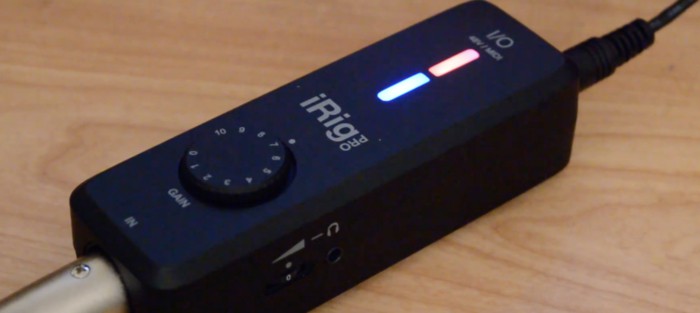
This portable piece of equipment is great for taking on the road, due to the fact it’s so small and light-weight.
It’s a fraction of the size of a Focusrite interface, and I use a different version of this product all of the time, an iRig HD 2, which is meant primarily for guitars.
The iRig Pro I/O, however, can be used for vocals and other instruments and is compatible with Mac, PC, iOS, macOS, and Android.
Unlike the Focusrite Interfaces, however, the iRig set-ups are typically made out of plastic, which I’m not a huge fan of, but it still performs its function well.
The iRig Pro I/O has on it two LED lights, with one being red and the other blue. If the top light is red, that means Phantom Power is on, and it’ll turn Blue or Green for MIDI in and Out signals.

The Gain LED display signifies different things, however. If it’s red, it means that the signal is clipping or “too hot.”
On the bottom of the device, is where the XLR and 1/4 inch combination cord is. This means that it’s good for both guitars and vocals.
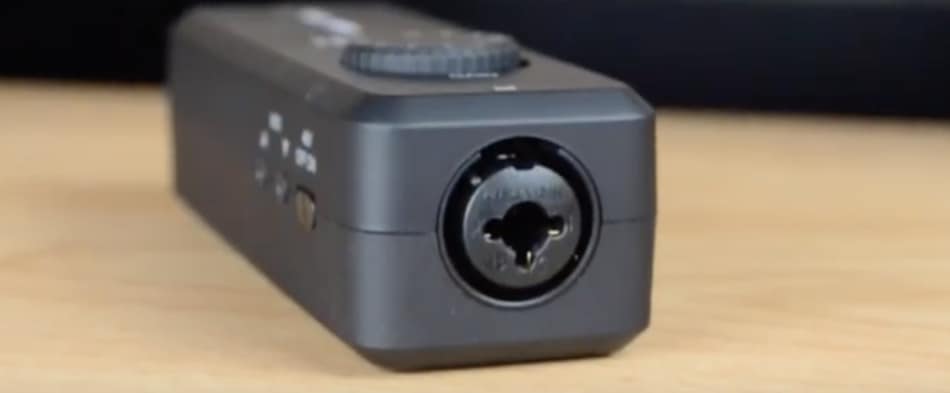
On the right of it, it has the headphone jack as well as the volume control. On the left of it, you have the switch for Phantom Power, which I explained in detail above, in addition to the MIDI inputs and MIDI outports.

The top of it features a digital output which is meant for connecting to your computer or your phone.

It comes with a USB cable as well as two MIDI brake cables. It also comes with batteries, which is for Phantom Power on account of mobile recordings, as well as a USB cable for charging.
You can also power the device with the DC input, so it’ll charge your phone as well at the same time. However, you need a cable to do this as it doesn’t come with the cable.
Truthfully, this piece of machinery works the best for mobile systems, including iOS. There’s no question that this thing is all about convenience and portability.

So, let’s move on to the specifications.
It records at 24-bit and 96kHz. You’ll notice that this device as the same bit-depth as the Focusrite Interface, but it doesn’t have as strong of a sampling rate.
In other words, the Focusrite Saffire 2i2 has a more quality sampling rate, thus a better sound, however, the iRig Pro I/O isn’t meant for the highest quality recordings, it’s meant for portability and ease of use while traveling.
Moreover, there’s no latency when recording so that’s good for you to know.
The other great thing about this product is the fact it comes with other downloadable content from IK Multimedia, including Amplitube for iOS, which is the amplifier simulation software that many guitarists and bassists are using nowadays, however, the full version from Plugin Fox is way better.
YouTube Video Tutorial
Conclusion
I hope this tutorial was helpful to you. There was a lot of information and specifications to unpack in this, so I hope I managed to elucidate some concepts which will help you in your purchase of the right product.
Make sure to share it on social media with your producer friends, it would be greatly appreciated.


 Written By :
Written By :